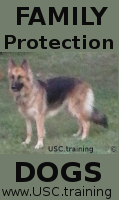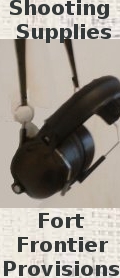
Sports
 |
USC |
On
The Wing Sports |
| USC.training |
Next Lesson ---> |
| The First Axiom
of Firearms Handling
is: "BE CAREFUL and THINK!" A person cannot do this fully if they are intoxicated by alcohol or under the influence of sense numbing or mind altering drugs. Do not mix these with guns. Being Careful and Thinking must be a continuous and vigilant behavior when handling firearms. You must be aware of your surroundings and you must be able to anticipate changes in your environment in enough time to preempt possible unsafe and high risk conditions. You must know your own skill level and continually work to improve this. You must be totally familiar with your equipment. You must focus on developing the habits that reduce the risks for more and more possible contingencies. You must be fully awake and focused on safety. In our Club we have 3 Axioms of Firearms Handling that you must fully understand and follow to handle firearms. There will be no one who is drunk or on drugs allowed. No one may handle a firearm if they are Distracted, Distraught, Disturbed, Immature, Negligent, Nonchalant, or otherwise not careful and thinking. Persons who are angry should not handle firearms. Anger may be a motivator for needed action, but the need should be reevaluated without the emotion before action is taken. Put the gun down when you are angry. Persons who are not in control of their emotions should not handle firearms. Fear may be a motivator for needed action and there may be no time for long evaluation of the need in these circumstances. If you are not capable of controlling your fears and conducting logical risk management, both in advance with scenario training, and on the spot; you should rely on someone else for actions requiring firearms. We have Three All Important Axioms of Firearms Handling and we use certain words & phrases, or yell out commands or warnings, and everyone must understand and agree on the meaning. For example: Cease Fire! is clear English & everyone in this room probably thinks they know what it means. Who knows what this means? Did you say "Cease Fire" means to stop firing but also open the action and unload your gun and step back from the firing line, put down the firearm or point in Safe direction? I am sure that all of you knew the basic English meaning of stop firing, do not pull the trigger. -- But in our club, and when you are on the range here, "Cease Fire" means to 'Stop Firing' and open the action and unload the gun and place firearm on the bench and step back from the firing line on the pistol or rifle range, or on the Trap Field - Stop Firing - open the action - unload the gun - hold muzzle in new the new "Safe Direction" pointed up into the air, or down at the ground, because pointing downrange, when the Range is "Hot" may be a safe direction, but when Cease Fire has been called, pointing up in the air is safer. How many steps did I say there are to take when "Cease Fire" is called on the Rifle Range? How many steps did I say there are to take when "Cease Fire" is called on the Trap field? |
 |
Our Second Axiom is "Always Point the Muzzle in a Safe Direction" and the meaning of this is the next thing that we are going to cover... But you see, "Cease Fire" really takes 4 or 5 different English phrases or steps to describe what we do when the "Cease Fire" command is issued. It is like we have our own language. And this is why I want you to pay especially close attention to this short language lesson. When I am Instructor and you are in our club, you and I must totally agree on the meaning of these few terms. Point Muzzle in a Safe Direction is a phrase that I may say a lot, but if it is because you need someone to keep saying this, you will not get very far in this course. We have a few terms in our club language that I like to call "fuzzy" (which I will get to); but Pointing Muzzle, and "Safe Direction" have definite hard, firm meanings in our club. The first part of the phrase is "Pointing Muzzle": Pointing Muzzle is not the same as "Aiming". Aiming is what you do for a short time when you are sure of your target and what is beyond it. Pointing Muzzle is not a single short time action verb, but is a continuing process of FOCUS and AWARENESS and possible adjustment of position from the time that you pick up the gun, until you put it down. When the gun is in your hand you ARE "Pointing the Muzzle" and you are responsible for the direction that the Muzzle is Pointed until you put it down. This includes every split second that the gun is in your hand - there are no gaps or breaks...Even when your cell phone rings, or your hat is blown away in the wind.... when you try to fire the gun and a squib load neither shoots your shot down range, or ejects your shell the way that you expected and the small pop that you heard indicates that you must now inspect the gun barrel for obstruction - you STAY FOCUSED ON WHERE YOU ARE POINTING THE MUZZLE WHEN THE GUN IS IN YOUR HAND! "Always Point the Muzzle in a Safe Direction" is the most important thing to do in basic firearms handling. "Pointing Muzzle" is a simple concept...An easy to understand definition, but the hard part is maintaining the focus on where you are Pointing the Muzzle...and for this we must train. [A gun never points itself but a muzzle is always pointed somewhere. The Muzzle is Pointed in the direction that the last person who touched it Pointed it. Or the person holding it is Pointing the Muzzle NOW!] A "Safe Direction" also has a hard and fast meaning. Now before you stand up to disagree with this statement, remember that this is not one of our fuzzy terms. Some of you may say that you can't be truly and totally safe - as those who have thought about it know that, for example: just buying a gun to keep in the home doesn't make you safe. You must also train to use the firearm competently, and you must tightly control who has access to the firearm, and even then you have only reduced certain risks. You may be safer, but it is a matter of "Risk Management" You can only make the home safer if you have analyzed the risks based on your lifestyle, the environment of your home, many things... it requires Thinking! Finding a "Safe Direction" in which to Point the Muzzle of a firearm also requires Thinking. When you can accurately predict where a bullet or shot would go, and can see where it will stop, and no persons, valuable property, or something that you would not be willing to shoot is in it's path -- you have found a "Safe Direction" When you can not see for as far as the bullet would travel in any direction, finding the direction is more problematic...it requires Thinking! We say that there is a "Safe Direction" because you must point that muzzle somewhere, so the safe direction is: after your assessment of the environment, the direction with lowest risks in your judgment. Normally, in-fact, when you are walking in a three dimensional space, the number of possible directions to Point the Muzzle is a very large number. There will be several "Safe Directions". When you are involved in activity involving your movement, or people around you are moving, or your environment is changing, your assessment of the Safest Direction may change. Now you may have to analyze whether new Risks mean that you should change the Muzzle Direction and how to do this with LEAST RISKS. You must carefully think through the movement, and where you will be Pointing the Muzzle at all times. At our club, free and open discussions about Safe Directions is encouraged. Anyone may make an observation, or know something about the environment that someone else does not. A simple example would be a person who is sitting in a wood frame building watching a person walk in with a gun pointed in a downward direction. The person entering may realize that a bullet could travel through the ceiling and harm someone on the second floor; but the person seated may know that the only other person in the building is in the basement. At our club, we will ALWAYS POINT THE MUZZLE IN A SAFE DIRECTION! This must not be forgotten. It is the responsibility of every individual who picks up a gun. It is a point of constant diligence at our club. In no uncertain terms! Anyone who does not have the motivation to follow or capacity to understand this instruction should not have access to any firearm. "Always Point the Muzzle in a Safe Direction" is an Important watchword and our Second Axiom of Firearms Handling. Now we also have "fuzzy" terms in our club language. But this is not necessarily because the term does not have a clear definition, but because the English language use of these words implies more than it should. The first of these terms is "Safety On". Now many new firearms are made with a device called a "Safety" and we ask: "Is the Safety On?" or "Is the Safety Off?" The firearm may even have a marking "Safe" for when the Safety device is in ON position; but the other possible misunderstanding of the language as well as the possible confusion of which way is which greatly reduces the value of these devices. Anyone could easily think that Safety is ON when it is not for many reasons. You may have just forgotten. Someone else may have tripped it. These devices may malfunction, may stick, may be broken, may have been removed. Granted, they can lower risks when they work after a firearm is dropped, or when the trigger is pulled accidentally by a tree branch, or finger of a person who is falling after tripping, or activities of other persons too close. But would it change the fact that we are always going to point muzzle in a safe direction? Of course not! It might be better to call it a Trigger Lock, or Hammer Disengagement, or some such, but they work different ways, and many guns simply do not have it. The best way to benefit from these devices is to KNOW how it works, KEEP it clean, KNOW the condition of your gun, and DON'T COUNT ON IT! Second fuzzy term is the "Unloaded" gun. We will be using this term a lot, and we will be covering how to "unload" various guns, and how to check to see if they are "unloaded". But the fuzzy quality of the term "unloaded" comes from a possible implication that our Second Axiom might not apply to an "unloaded" gun. The simple rule is: Always Point the muzzle in a safe direction applies to all guns at all times "unloaded" or not. Many people have been killed by fools who mishandled an "unloaded" gun. A person can make many mistakes in their lives, and most can be corrected or reversed, but there are a few that are permanent. You should never assume that a gun is "unloaded". When you pick it up, or someone hands it to you, check to see that it is "unloaded". Check to see that the magazine is empty and check to see that the chamber(s) is/are empty. Never depend on someone else to do this check for you. Never skip the check because you believe that you were the last one to handle the gun. Never rely on a count of removed cartridges to determine a gun is "unloaded". Never rely on lack of ammo supply. Never assume a gun to be "unloaded" because of a storage method or location. Never assume that a gun is "unloaded" because of a count of fired rounds. The fuzzy terms are discussed now, even before the all important Third Axiom of Firearms Handling to "Be Sure of your Target and what is Beyond It" because of the importance of not assuming that the Second Axiom might not apply to "unloaded" guns. When communicating using the term "unloaded" for purposes other than affecting Pointing the Muzzle Direction, such as access control to a loadable gun may be necessary. In our club, the definition of "unloaded" when the magazine has been removed from the receiver of the gun, the chamber is empty, the gun is not "unloaded" until cartridges have been removed from the magazine. When an "unloaded" gun is in the same drawer with a box of ammo to fit, the gun is "unloaded" when chamber and magazine have been checked. Is this useful information? Only when you are also very careful, and have thought through the scenarios. Still a fuzzy term! The Third Axiom of firearms handling is "Be Sure of your Target and what is Beyond It" Know where your shot will go if you miss your target or the bullet ricochets. Know where a bullet which penetrates its intended target will stop. Be aware of anything that could move into the line of fire. Be sure of your target before you put your finger on the trigger. This requires knowledge of the target, environment, your skills, your equipment. Acquire this through study, analysis, & training. The Firearms Axioms 123 are about practices, procedures, and attitudes that should help avoid mistakes and errors. The "Knowledge Of Your Target" part of Axiom #3 is about avoiding errors as well as being certain of your intentions. Axiom #3 - BE SURE OF YOUR TARGET is the most important part of deliberate firearms shooting. |
 |
| USC.training |
Next Lesson ---> |